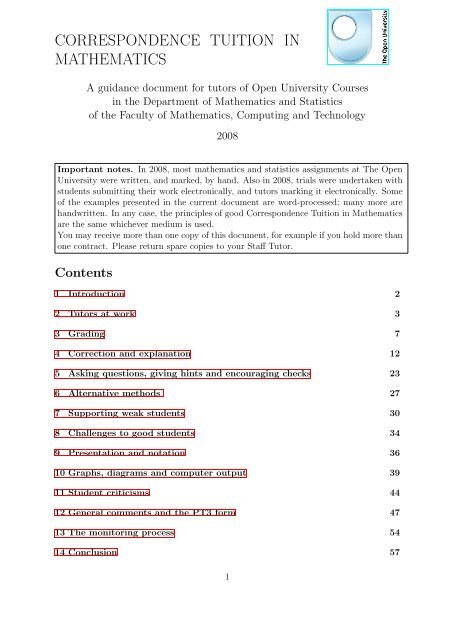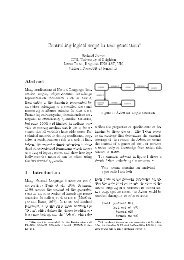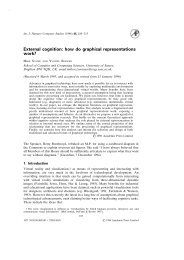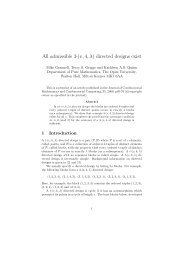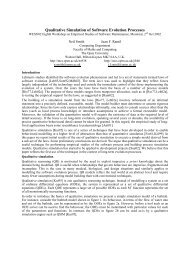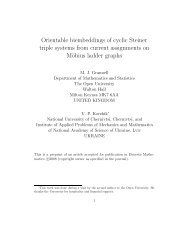correspondence tuition in mathematics - Faculty of Maths and ...
correspondence tuition in mathematics - Faculty of Maths and ...
correspondence tuition in mathematics - Faculty of Maths and ...
Create successful ePaper yourself
Turn your PDF publications into a flip-book with our unique Google optimized e-Paper software.
CORRESPONDENCE TUITION IN<br />
MATHEMATICS<br />
A guidance document for tutors <strong>of</strong> Open University Courses<br />
<strong>in</strong> the Department <strong>of</strong> Mathematics <strong>and</strong> Statistics<br />
<strong>of</strong> the <strong>Faculty</strong> <strong>of</strong> Mathematics, Comput<strong>in</strong>g <strong>and</strong> Technology<br />
2008<br />
Important notes. In 2008, most <strong>mathematics</strong> <strong>and</strong> statistics assignments at The Open<br />
University were written, <strong>and</strong> marked, by h<strong>and</strong>. Also <strong>in</strong> 2008, trials were undertaken with<br />
students submitt<strong>in</strong>g their work electronically, <strong>and</strong> tutors mark<strong>in</strong>g it electronically. Some<br />
<strong>of</strong> the examples presented <strong>in</strong> the current document are word-processed; many more are<br />
h<strong>and</strong>written. In any case, the pr<strong>in</strong>ciples <strong>of</strong> good Correspondence Tuition <strong>in</strong> Mathematics<br />
are the same whichever medium is used.<br />
You may receive more than one copy <strong>of</strong> this document, for example if you hold more than<br />
one contract. Please return spare copies to your Staff Tutor.<br />
Contents<br />
1 Introduction 2<br />
2 Tutors at work 3<br />
3 Grad<strong>in</strong>g 7<br />
4 Correction <strong>and</strong> explanation 12<br />
5 Ask<strong>in</strong>g questions, giv<strong>in</strong>g h<strong>in</strong>ts <strong>and</strong> encourag<strong>in</strong>g checks 23<br />
6 Alternative methods 27<br />
7 Support<strong>in</strong>g weak students 30<br />
8 Challenges to good students 34<br />
9 Presentation <strong>and</strong> notation 36<br />
10 Graphs, diagrams <strong>and</strong> computer output 39<br />
11 Student criticisms 44<br />
12 General comments <strong>and</strong> the PT3 form 47<br />
13 The monitor<strong>in</strong>g process 54<br />
14 Conclusion 57<br />
1
1 Introduction<br />
As an Associate Lecturer (AL) <strong>of</strong> the Open University, you have access to the Support<strong>in</strong>g<br />
Open Learners (SOL) website, http://www.open.ac.uk/tutors/sol/. The site<br />
provides a good reference guide to general aspects <strong>of</strong> <strong>correspondence</strong> <strong>tuition</strong>, resources to<br />
aid ALs <strong>in</strong> support<strong>in</strong>g their students, <strong>and</strong> also the adm<strong>in</strong>istrative <strong>in</strong>formation you need<br />
to deal with Tutor-Marked Assignments (TMAs). We suggest that you take a look at the<br />
website before you cont<strong>in</strong>ue with this document.<br />
It takes time to assimilate the more general material on the SOL site, <strong>and</strong> to relate<br />
comments to the task <strong>in</strong> h<strong>and</strong> – particularly if you’re new to the University. Correspondence<br />
<strong>tuition</strong> <strong>in</strong> <strong>mathematics</strong> is, <strong>in</strong> some ways, rather different from <strong>correspondence</strong><br />
<strong>tuition</strong> <strong>in</strong> subjects that <strong>in</strong>volve students primarily <strong>in</strong> essay writ<strong>in</strong>g.<br />
We therefore th<strong>in</strong>k it’s helpful to provide you with a subject-specific booklet: you may<br />
appreciate the chance to see illustrations <strong>of</strong> general pr<strong>in</strong>ciples at work <strong>in</strong> <strong>mathematics</strong>,<br />
through examples <strong>of</strong> students scripts <strong>and</strong> the comments that tutors have made on them.<br />
New courses <strong>and</strong> chang<strong>in</strong>g methods <strong>of</strong> delivery, especially electronic mark<strong>in</strong>g, will give<br />
opportunities for a different process for provid<strong>in</strong>g <strong>correspondence</strong> <strong>tuition</strong> compared to paper<br />
mark<strong>in</strong>g. Nevertheless, the common core <strong>of</strong> good practice rema<strong>in</strong>s the same whatever<br />
the medium – so the ideas illustrated here rema<strong>in</strong> relevant.<br />
Tutors naturally have <strong>in</strong>dividual styles <strong>of</strong> comment<strong>in</strong>g, <strong>and</strong> what sounds right when<br />
written by one can sound artificial from another. This makes it tricky to lay down a<br />
set <strong>of</strong> hard-<strong>and</strong>-fast rules for good <strong>correspondence</strong> <strong>tuition</strong>, but there are guidel<strong>in</strong>es to<br />
follow. These are set out <strong>in</strong> detail <strong>in</strong> Sections 3 to 12, where we also provide coverage <strong>of</strong><br />
some frequently encountered situations, along with examples <strong>of</strong> a variety <strong>of</strong> tutors ways<br />
<strong>of</strong> deal<strong>in</strong>g with them.<br />
The po<strong>in</strong>ts we make are illustrated by <strong>in</strong>stances <strong>of</strong> what we consider both good <strong>and</strong><br />
bad tutor<strong>in</strong>g practice; for simplicity, most <strong>of</strong> the examples are taken from first <strong>and</strong> second<br />
level courses. Although there may not be any from the course which you’re teach<strong>in</strong>g, we<br />
hope that many <strong>of</strong> the examples will be relevant to your work. We believe they cover most<br />
<strong>of</strong> the different types <strong>of</strong> situation that are likely to arise <strong>in</strong> <strong>mathematics</strong> <strong>and</strong> statistics<br />
courses.<br />
We beg<strong>in</strong> the booklet with some thoughts upon start<strong>in</strong>g to mark a batch <strong>of</strong> scripts for<br />
courses which we tutor ourselves. This is followed by the ma<strong>in</strong> sections, <strong>in</strong>clud<strong>in</strong>g a range<br />
<strong>of</strong> examples; then we look at the monitor<strong>in</strong>g process <strong>and</strong> how it will affect you. The back<br />
cover provides an at-a-glance summary sheet <strong>of</strong> good practice po<strong>in</strong>ts that can be used<br />
alongside the Tutor Notes for your course.<br />
We hope that this booklet will help you to:<br />
• establish processes to manage your mark<strong>in</strong>g <strong>of</strong> TMAs;<br />
• grade student work <strong>in</strong> accordance with the guidel<strong>in</strong>es for your course;<br />
• encourage student progress through appropriate feedback;<br />
2
• appreciate monitor<strong>in</strong>g as a quality assurance mechanism <strong>and</strong> as part <strong>of</strong> staff development;<br />
<strong>and</strong><br />
• know how to obta<strong>in</strong> further help if needed.<br />
We, the authors, would like to thank those who wrote the orig<strong>in</strong>al document upon<br />
which the current version is based, <strong>and</strong> the many others who have helped <strong>in</strong> the revision;<br />
academic, secretarial, full-time <strong>and</strong> part-time staff, <strong>in</strong>clud<strong>in</strong>g Associate Lecturers who<br />
have, know<strong>in</strong>gly or unknow<strong>in</strong>gly, provided examples for our use.<br />
Gaynor Arrowsmith Mike Innes Gwil Stephenson<br />
Cath Gornall Alison Neil Cath Wilk<strong>in</strong>s<br />
Ian Harrison Sylvia Neumann Frances Williams<br />
Mike Herr<strong>in</strong>g Philip Shelton Gareth Williams<br />
2 Tutors at work<br />
MST121 Us<strong>in</strong>g Mathematics – Cath<br />
I have my first batch <strong>of</strong> MST121, Us<strong>in</strong>g Mathematics, preparatory TMAs to mark. This<br />
is a formative assignment <strong>and</strong> students are encouraged to submit it as early as possible,<br />
so scripts tend to arrive over a couple <strong>of</strong> weeks. It is important for students to receive<br />
early feedback, so I mark the TMAs <strong>and</strong> send them to Walton Hall as soon as I can.<br />
The preparatory TMA is an opportunity for me to judge whether students are ready<br />
to study MST121. Many <strong>of</strong> the assignments will be very good <strong>and</strong> will need only brief<br />
comments. However, I am go<strong>in</strong>g to have to be very careful with the ones that are not so<br />
good; most <strong>of</strong> the students are new to the Open University <strong>and</strong> I dont want to put them<br />
<strong>of</strong>f at this early stage. At the same time, I need to be realistic about their work <strong>and</strong> it<br />
may be that they should be th<strong>in</strong>k<strong>in</strong>g about chang<strong>in</strong>g course (probably to MU120, Open<br />
Mathematics), but I have to be very sensitive about this. I will follow up any weak scripts<br />
with a phone call a few days after they have received their scripts back.<br />
Question 1 is on numbers <strong>in</strong>clud<strong>in</strong>g surds, powers, <strong>and</strong> logarithms. It is answered very<br />
well, although some students have not shown all their work<strong>in</strong>g <strong>and</strong> I comment on the<br />
importance <strong>of</strong> this.<br />
Questions 2, 3 <strong>and</strong> 4 are on algebra <strong>in</strong>clud<strong>in</strong>g solv<strong>in</strong>g equations <strong>and</strong> <strong>in</strong>equalities. Some<br />
students reveal that their techniques are a little rusty. I stress the need for fluent algebra<br />
skills <strong>and</strong> suggest that some extra practice might be useful, provid<strong>in</strong>g references to helpful<br />
sections <strong>of</strong> the Revision Pack. In particular, a number <strong>of</strong> students seem overly reliant on<br />
the quadratic formula <strong>and</strong> I show them how they could have obta<strong>in</strong>ed some results more<br />
easily us<strong>in</strong>g factorisation.<br />
Question 5 is on l<strong>in</strong>ear graphs, po<strong>in</strong>ts <strong>of</strong> <strong>in</strong>tersection <strong>and</strong> simultaneous equations. Most<br />
students have provided very good answers, although there is some reluctance to add any<br />
words expla<strong>in</strong><strong>in</strong>g what they’re do<strong>in</strong>g.<br />
Questions 6 <strong>and</strong> 7 are on geometry <strong>and</strong> trigonometry <strong>in</strong>clud<strong>in</strong>g the use <strong>of</strong> radians. Most<br />
students clearly know what they are do<strong>in</strong>g, but many <strong>of</strong> them have <strong>in</strong>troduced round<strong>in</strong>g<br />
3
errors <strong>and</strong> I expla<strong>in</strong> how this can be avoided. There are also some presentational issues<br />
to comment on, such as <strong>in</strong>appropriate use <strong>of</strong> the equals symbol. Once aga<strong>in</strong> I comment<br />
on the need for clear explanations. This is clearly a common problem!<br />
Question 8 is an ungraded question <strong>in</strong>vit<strong>in</strong>g students to share with the tutor some<br />
details <strong>of</strong> their mathematical background, feel<strong>in</strong>gs about their preparatory work <strong>and</strong> plans<br />
to improve their study methods. Some students will choose not to do this. For those who<br />
have, I comment briefly on the po<strong>in</strong>ts raised <strong>and</strong> thank them for the <strong>in</strong>formation. I also<br />
make a note to contact any student who has raised an issue I th<strong>in</strong>k may need further<br />
discussion.<br />
A couple <strong>of</strong> days after the course <strong>of</strong>ficially starts I will contact any students who have<br />
not submitted the preparatory TMA. There may be one or two who are not <strong>in</strong>tend<strong>in</strong>g<br />
to cont<strong>in</strong>ue with the course <strong>and</strong> I will rem<strong>in</strong>d them to contact the Regional Centre to<br />
withdraw as soon as possible. There may also be some who are reluctant to tackle the<br />
TMA or who have registered late <strong>and</strong> I will encourage them to try perhaps just two or<br />
three <strong>of</strong> the questions, whilst rem<strong>in</strong>d<strong>in</strong>g them <strong>of</strong> the importance <strong>of</strong> future cut-<strong>of</strong>f dates.<br />
MS221 Explor<strong>in</strong>g Mathematics – Alison<br />
It is the day after the cut-<strong>of</strong>f date for TMA02 <strong>and</strong> I have a pile <strong>of</strong> scripts to mark. I<br />
have begun to know my students by now <strong>and</strong> am glad to have the opportunity to read<br />
their work <strong>and</strong> see how they are gett<strong>in</strong>g on. I like to mark one script at a time, so I<br />
can engage with each student <strong>and</strong> get a good overall impression <strong>of</strong> their strengths <strong>and</strong><br />
weaknesses. Occasionally I’ll take one question <strong>and</strong> mark it for a batch <strong>of</strong> scripts, if I<br />
anticipate difficulties with the mark<strong>in</strong>g, but that’s not so this time. I like to start <strong>of</strong>f<br />
with a very good assignment if possible, just to get <strong>in</strong>to the sw<strong>in</strong>g <strong>of</strong> the mark scheme,<br />
before tackl<strong>in</strong>g weaker ones where there will be more problems. I have my black <strong>and</strong> blue<br />
pens ready, as I always use black for students who write <strong>in</strong> blue, <strong>and</strong> vice versa, hav<strong>in</strong>g a<br />
personal aversion to red <strong>in</strong>k.<br />
The first question is about fixed po<strong>in</strong>ts. Inevitably some students will still be us<strong>in</strong>g<br />
the quadratic formula rather than factoris<strong>in</strong>g neatly, so that will be worth a comment.<br />
Some students leave out the modulus signs when test<strong>in</strong>g the nature <strong>of</strong> the fixed po<strong>in</strong>ts, so<br />
that needs an important note, <strong>and</strong> the loss <strong>of</strong> a mark for reason<strong>in</strong>g. If they get the fixed<br />
po<strong>in</strong>ts wrong, I will have to follow-through the marks for the rest <strong>of</strong> the question.<br />
I add up the marks, <strong>and</strong> as a check add the lost marks too, round<strong>in</strong>g up any odd<br />
half-mark at the end. I tend not to penalise for <strong>in</strong>correct notation, though I always po<strong>in</strong>t<br />
it out – misuse <strong>of</strong> = signs is a frequent one! – but I take <strong>of</strong>f half a mark when I’m really<br />
unhappy about it. Occasionally too, where the mark scheme doesn’t dictate otherwise,<br />
I’ll take <strong>of</strong>f half a mark for <strong>in</strong>correct round<strong>in</strong>g or for small omissions. I have a pocketful<br />
<strong>of</strong> words such as “good” or “all f<strong>in</strong>e” or “beautifully clear”, with which I scatter nicely<br />
done sections.<br />
Question 2 requires the use <strong>of</strong> Mathcad; a few students leave it out completely, claim<strong>in</strong>g<br />
computer problems, or lack <strong>of</strong> time. Most tackle it quite well, but some lose marks through<br />
their reluctance to write detailed conclusions, leav<strong>in</strong>g it for me to pick out their answers<br />
4
<strong>in</strong> their pr<strong>in</strong>t-outs, which, to compound matters, are sometimes appended at the back <strong>of</strong><br />
their scripts! Others fail to <strong>in</strong>crease the number <strong>of</strong> iterations sufficiently to get a clear<br />
picture <strong>of</strong> any convergence: the sequence converges to an 8-cycle after about a hundred<br />
iterations, but many just look at ten iterations <strong>and</strong> conclude the sequence is chaotic. So<br />
there is plenty <strong>of</strong> scope for comment.<br />
The next question is short, about b<strong>in</strong>omial coefficients, <strong>and</strong> many students get full<br />
marks, so it’s a quick <strong>and</strong> easy one for me. But for some there’s confusion between “term”<br />
<strong>and</strong> “coefficient”, <strong>and</strong> there are a few sign errors, <strong>and</strong> some decimal approximations to<br />
what should be exact answers.<br />
Question 4 is about transformations <strong>and</strong> matrices. I sense that a few students are<br />
writ<strong>in</strong>g down solutions by rote, with little underst<strong>and</strong><strong>in</strong>g <strong>of</strong> what they are do<strong>in</strong>g, so if<br />
there is not enough justification they will lose a mark, <strong>and</strong> I’ll fill <strong>in</strong> the reason<strong>in</strong>g for<br />
them as clearly as I can. At the end there is another Mathcad exercise, about writ<strong>in</strong>g<br />
a matrix as a product <strong>of</strong> simple scal<strong>in</strong>g / shear / rotation matrices, with neat diagrams<br />
show<strong>in</strong>g a unit square be<strong>in</strong>g transformed <strong>in</strong>to a parallelogram, but I get several scripts<br />
which tell me that the matrix is just the identity I, so clearly they had no idea <strong>of</strong> what<br />
they were supposed to do, <strong>and</strong> I refer them to the box <strong>and</strong> activity <strong>in</strong> the computer<br />
booklet which expla<strong>in</strong>s the process; they still get 2 <strong>of</strong> the 5 marks though, for enter<strong>in</strong>g<br />
the orig<strong>in</strong>al matrix correctly.<br />
Next, Question 5 is about aff<strong>in</strong>e transformations <strong>and</strong> composites, with more matrices.<br />
Most <strong>of</strong> the students run <strong>in</strong>to trouble here, <strong>of</strong>ten with f<strong>in</strong>d<strong>in</strong>g the composite (there’s<br />
no similar example <strong>in</strong> the chapter or <strong>in</strong> the exercise book); so I congratulate those who<br />
worked it out correctly for themselves, <strong>and</strong> write solutions for those who got stuck. I also<br />
have to do quite a lot <strong>of</strong> follow-through mark<strong>in</strong>g!<br />
There are issues <strong>of</strong> notation here too; use <strong>of</strong> brackets, underl<strong>in</strong><strong>in</strong>g vectors, dist<strong>in</strong>guish<strong>in</strong>g<br />
between a vector <strong>and</strong> a po<strong>in</strong>t.<br />
Lastly Question 6 is about eigenvalues, eigenl<strong>in</strong>es, <strong>and</strong> eigenvectors. Nearly everyone<br />
gets the first two or three sections right; for those who don’t I po<strong>in</strong>t out how they could<br />
have checked their answers (if the square matrix A has <strong>in</strong>teger entries, so should the<br />
matrix A 6 !). But there are more problems <strong>in</strong> the later sections, about the behaviour<br />
<strong>of</strong> iteration sequences <strong>of</strong> po<strong>in</strong>ts start<strong>in</strong>g on or <strong>of</strong>f an eigenl<strong>in</strong>e, with one section another<br />
Mathcad exercise. Often their description <strong>of</strong> the behaviour lacks detail <strong>and</strong> justification,<br />
<strong>and</strong> I’m not always sure they see the l<strong>in</strong>ks between the various parts <strong>of</strong> the question,<br />
so I write out the solution for them <strong>and</strong> refer them to to the detailed description <strong>in</strong> the<br />
h<strong>and</strong>book, <strong>and</strong> to similar activities <strong>in</strong> the chapter. It might have been worth writ<strong>in</strong>g out<br />
my own solution once <strong>and</strong> for all, <strong>and</strong> photocopy<strong>in</strong>g it , but I do like to tie up the solution<br />
<strong>and</strong> notes I write on their script with their work as much as possible.<br />
F<strong>in</strong>ally I write up the PT3 form. I always address it to the student, (hop<strong>in</strong>g at the<br />
start <strong>of</strong> the course to have their first name right!), <strong>and</strong> I aim to write <strong>in</strong> a friendly,<br />
positive style. There is always someth<strong>in</strong>g I can praise to start with, a question which got<br />
full marks, good presentation, neat diagrams, etc. I know full well that for some students<br />
a mark <strong>of</strong> 60%, say, is quite an achievement <strong>and</strong> that with support <strong>and</strong> encouragement<br />
they may be able to improve on this. I draw their attention to two or three po<strong>in</strong>ts to note<br />
5
especially, e.g use <strong>of</strong> modulus signs, or how to form composites; I hope this encourages<br />
them to look at my comments <strong>in</strong>side <strong>and</strong> may be useful later when they are revis<strong>in</strong>g for<br />
the exam. I f<strong>in</strong>ish by look<strong>in</strong>g ahead to the next block, <strong>and</strong> encourag<strong>in</strong>g them to contact<br />
me if they have queries or run <strong>in</strong>to difficulties. If any student seems to be struggl<strong>in</strong>g I’ll<br />
make a note to contact them.<br />
Then it’s onto the next student’s script; it’s good to see the pile go<strong>in</strong>g down <strong>and</strong> even<br />
better to get them all <strong>in</strong> the post!<br />
M208 Pure Mathematics – Ian<br />
It is the day after the cut-<strong>of</strong>f date for TMA03 <strong>of</strong> M208, Pure Mathematics. I had about<br />
six scripts a week ago; this is somewhat unusual by this stage <strong>of</strong> the course, but a few<br />
students told me they needed to get ahead because <strong>of</strong> holidays or go<strong>in</strong>g abroad. As the<br />
assignments came <strong>in</strong> I noted their arrival date on the PT3 <strong>and</strong> collected them together<br />
<strong>in</strong> one large envelope. When about six had come <strong>in</strong>, as I had a day available, I started<br />
mark<strong>in</strong>g them. I always mark script by script, but like to have a reasonable number before<br />
I get go<strong>in</strong>g so that I can compare them <strong>and</strong> check that I am be<strong>in</strong>g consistent, especially<br />
over errors that appear repeatedly.<br />
I’ve made a few comments on my Tutor Notes by now – some extra references which<br />
may be useful, a note <strong>of</strong> any errors, <strong>of</strong> common alternative solutions <strong>and</strong> <strong>of</strong> any po<strong>in</strong>ts<br />
where the mark scheme seems a bit odd <strong>and</strong> I may need to use my discretion over a mark<br />
or two. Just after the cut-<strong>of</strong>f date I’ve sent <strong>of</strong>f the first batch; I don’t send them too early<br />
<strong>in</strong> case the students should then get them back before the cut-<strong>of</strong>f date <strong>and</strong> show their<br />
fellow students any <strong>of</strong> my model solutions!<br />
I have given four students permission to send this TMA <strong>in</strong> late, but most <strong>of</strong> the rest<br />
have now come <strong>in</strong>, so I get out my green pen to get on with the next batch. This TMA<br />
is one which most people can do fairly well, but many <strong>of</strong> them get the notation slightly<br />
wrong, so that is someth<strong>in</strong>g I have to pay particular attention to. There’s also a lot <strong>of</strong><br />
arithmetic <strong>in</strong>volved, <strong>and</strong> <strong>of</strong> course this means there are numerical mistakes which may<br />
make subsequent answers wrong.<br />
I have to check the follow-through carefully, but sometimes the errors mean that the<br />
later work is easier than the correct solution, <strong>in</strong> which case I don’t give all the followthrough<br />
marks. I po<strong>in</strong>t out checks that could be done to avoid or correct these errors.<br />
Question 5 is rather tricky <strong>and</strong> I f<strong>in</strong>d myself writ<strong>in</strong>g out all or part <strong>of</strong> a solution quite<br />
<strong>of</strong>ten. In retrospect perhaps I should have written it out once <strong>and</strong> made some photocopies<br />
to attach to some scripts. As I mark each question, where I deduct marks I write the<br />
negative marks on the sp<strong>in</strong>e <strong>of</strong> the PT3 form.<br />
If a student is do<strong>in</strong>g well – not los<strong>in</strong>g marks – I may not itemise every subtotal from<br />
the mark scheme, but carry marks through until I come to an error. Then I shall write<br />
an appropriate itemised mark at the end <strong>of</strong> the section before the mistake, so that I can<br />
show more detail with the marks where there is an error.<br />
At the end <strong>of</strong> mark<strong>in</strong>g a question, I add up the marks on the script <strong>and</strong> check with<br />
the negative marks, before writ<strong>in</strong>g the total for the question <strong>in</strong> the appropriate box. On<br />
6
the PT3, I draw a l<strong>in</strong>e under the negative marks so far, <strong>in</strong> order to separate them from<br />
those for the next question.<br />
At the end <strong>of</strong> mark<strong>in</strong>g an assignment, I have the double check <strong>of</strong> the totals <strong>in</strong> the boxes<br />
<strong>of</strong> the PT3 aga<strong>in</strong>st the total negative marks on the sp<strong>in</strong>e. A significant proportion <strong>of</strong> PT3<br />
forms from <strong>mathematics</strong> tutors are rejected because the overall grade is not correct; I use<br />
the negative marks to try not to contribute to this problem!<br />
Before I write comments on the PT3 form I look at the student’s PT3 for TMA02,<br />
compare the grade achieved on the two assignments <strong>and</strong> look at the comments I wrote<br />
last time. Obviously I don’t want to use exactly the same words as before, but I also want<br />
to see whether the student has taken note <strong>of</strong> any suggestions I may have made previously.<br />
Some students have, <strong>and</strong> I commend them for this. At least one, however, is still los<strong>in</strong>g<br />
marks by writ<strong>in</strong>g far too little explanation; I tell him about it aga<strong>in</strong> <strong>and</strong> I hope he takes<br />
more notice this time!<br />
Another student – who cannot attend tutorials or day schools because she works on<br />
Saturdays – is hav<strong>in</strong>g a lot <strong>of</strong> difficulty. I’ve tried to persuade her to r<strong>in</strong>g me up for help,<br />
but she seems very reluctant to do so. So I will now take the <strong>in</strong>itiative <strong>and</strong> r<strong>in</strong>g her to<br />
suggest a “special session”. Most students are do<strong>in</strong>g well, however, <strong>and</strong> I’m pleased that<br />
this year I’ve only had one who’s withdrawn – though I suspect there may be another<br />
withdrawal about to happen. Next week I will telephone, or email, the three students<br />
who have neither sent <strong>in</strong> the TMA nor asked for an extension, <strong>in</strong> the hope <strong>of</strong> encourag<strong>in</strong>g<br />
them to cont<strong>in</strong>ue with the course even if they are hav<strong>in</strong>g problems.<br />
3 Grad<strong>in</strong>g<br />
Mark<strong>in</strong>g correct work is usually easy – it is when the student goes wrong that difficulties<br />
arise. Tutor notes try to <strong>in</strong>dicate the proportion <strong>of</strong> marks to give to different sections,<br />
<strong>and</strong> detail what the marks are for. Nevertheless you will f<strong>in</strong>d many occasions when you<br />
have to use your discretion if the tutor notes do not cover the type <strong>of</strong> answers given, <strong>and</strong><br />
the tutor notes may occasionally be <strong>in</strong>correct 1 . It is more important that you can justify<br />
the marks you have given than that you bl<strong>in</strong>dly obey the tutor notes.<br />
Grad<strong>in</strong>g is, <strong>in</strong> practice an <strong>in</strong>exact science. A difference <strong>of</strong> a few marks between tutors<br />
is the norm <strong>and</strong> it is only when a tutor differs from the average by a considerable amount,<br />
over the script as a whole, that alarm bells start to r<strong>in</strong>g.<br />
When mark<strong>in</strong>g there are certa<strong>in</strong> po<strong>in</strong>ts to bear <strong>in</strong> m<strong>in</strong>d:<br />
• It is important for the student to know why marks have been lost. In some cases it<br />
will be sufficient simply to correct an arithmetic error, but <strong>in</strong> all other cases, any<br />
loss <strong>of</strong> marks must be supported by an explanation to the student.<br />
• Some <strong>in</strong>dication <strong>of</strong> where the loss has occurred must also be <strong>in</strong>dicated on the script.<br />
There are many ways <strong>of</strong> do<strong>in</strong>g this depend<strong>in</strong>g on how the question is structured.<br />
It is usual to enter part marks next to each section <strong>of</strong> a question <strong>in</strong> l<strong>in</strong>e with how<br />
1 Errata are usually posted on the tutors’ First Class forum for the course.<br />
7
the marks are del<strong>in</strong>eated <strong>in</strong> the question e.g. 3/5 for a part with 5 marks available<br />
<strong>and</strong> 3 awarded. This is particularly important if the student is hav<strong>in</strong>g difficulty<br />
with many aspects <strong>of</strong> the question. Occasionally, if the student is gett<strong>in</strong>g almost<br />
everyth<strong>in</strong>g correct, a simple “−1” (with explanatory comments), <strong>and</strong> a total mark<br />
for the question at the end, may be appropriate. The practice <strong>of</strong> always us<strong>in</strong>g part<br />
marks is probably the best, <strong>and</strong> is encouraged, as it does provide a check that all<br />
parts <strong>of</strong> the solution have been marked.<br />
• You may use abbreviations when mark<strong>in</strong>g scripts as long as the first time you use<br />
them you expla<strong>in</strong> to the student the code you are us<strong>in</strong>g. The commonest ones are<br />
“b.d.” (benefit <strong>of</strong> the doubt) when you feel the student has provided a correct answer<br />
but mis<strong>in</strong>terpreted or misread a fairly trivial aspect, <strong>and</strong> “f.t.” (follow through) when<br />
you have had to follow through an <strong>in</strong>correct solution to see what effects the <strong>in</strong>itial<br />
error may have had on other parts <strong>of</strong> a question, <strong>in</strong> order to avoid over-penalis<strong>in</strong>g a<br />
student for a s<strong>in</strong>gle error.<br />
• Non-st<strong>and</strong>ard but correct work, unless contrary to the word<strong>in</strong>g <strong>of</strong> the question or<br />
the spirit <strong>of</strong> the course, usually gets full marks.<br />
• In many cases, if no work<strong>in</strong>g is shown full marks cannot be awarded. The Tutor<br />
Notes should make the practice clear. It is <strong>of</strong>ten worth rem<strong>in</strong>d<strong>in</strong>g students to look<br />
at the part <strong>of</strong> the course which expla<strong>in</strong>s what level <strong>of</strong> detail is needed when words<br />
such as “write down,” “calculate” or “prove” are used <strong>in</strong> a question. (Often, they<br />
are expla<strong>in</strong>ed on the front cover <strong>of</strong> an assignment booklet.)<br />
• If a wrong answer is obta<strong>in</strong>ed with no work<strong>in</strong>g given, then, <strong>of</strong> course, neither method<br />
nor answer marks should be given.<br />
• Marks can always be split as you feel appropriate; e.g. if part <strong>of</strong> a question has 3<br />
answer marks you can mark between 0 <strong>and</strong> 3 depend<strong>in</strong>g on how good you th<strong>in</strong>k the<br />
answer is. Often the Tutor Notes will give a mark scheme with a detailed breakdown.<br />
On some courses you can even give half a mark if you wish, so long as you round<br />
up half marks to give an <strong>in</strong>teger mark for the whole question.<br />
• You can add marks for a particularly well executed piece <strong>of</strong> work to mitigate the<br />
loss <strong>of</strong> marks elsewhere with<strong>in</strong> the same question, but this is the exception rather<br />
than the rule. Where this does occur it should only <strong>in</strong>volve a slight adjustment <strong>of</strong> 1<br />
or 2 marks. In all cases, the total number <strong>of</strong> marks for each part <strong>of</strong> a question (as<br />
def<strong>in</strong>ed by the Assignment Booklet) must be respected.<br />
• It is important to notice the process a student has gone through to achieve an<br />
answer, as well as the f<strong>in</strong>al result. A correct numerical result obta<strong>in</strong>ed via false<br />
steps should not get full marks.<br />
• If you notice that two scripts are virtually identical, <strong>and</strong> you suspect that the two<br />
students concerned have collaborated more than is appropriate, or that one student<br />
8
has copied from the other, please consult your Staff Tutor before send<strong>in</strong>g the scripts<br />
to Walton Hall.<br />
F<strong>in</strong>ally, it is worth double-check<strong>in</strong>g that you have added up all the part marks correctly<br />
<strong>and</strong> that the overall assignment mark on the PT3 is correct. There is a fairly<br />
high percentage <strong>of</strong> assignments submitted where the overall grade is <strong>in</strong>correct, even on<br />
<strong>mathematics</strong> courses. Naturally, <strong>in</strong> our case it is only due to tiredness!<br />
In the example that follows the tutor has provided part marks. Note that, as shown<br />
<strong>in</strong> this example, a total mark for a question should appear next to the solution as well as<br />
on the PT3.<br />
Example 3.1 . MS221 02<br />
It is important to let the students know where marks have been lost. The next example<br />
demonstrates how a fairly brief message from the tutor can be very helpful. Note the use<br />
<strong>of</strong> “m<strong>in</strong>us one” <strong>in</strong> brackets mak<strong>in</strong>g it explicitly clear where the mark was lost, but more<br />
importantly the part mark has been given as well.<br />
Example 3.2 . M208 03<br />
9
In the follow<strong>in</strong>g example, the solution <strong>in</strong> the Tutor Notes starts by stat<strong>in</strong>g un+1 =<br />
8 n+1 +(−6) n+1 <strong>and</strong> un−1 = 8 n−1 +(−6) n−1 separately, before substitut<strong>in</strong>g <strong>in</strong>to un+1un−1 −<br />
u 2 n. The tutor has docked a mark because the student hasn’t done this. But the question<br />
didn’t specify that this was explicitly needed, <strong>and</strong> the solution is perfectly clear, so <strong>in</strong> fact<br />
full marks would have been appropriate here.<br />
It is <strong>of</strong>ten obvious that a question was unclear if most students make the same mistake.<br />
Unfortunately, it is usually not obvious until after you have marked quite a few scripts.<br />
For this reason, it is wise to reta<strong>in</strong> early scripts until you are happy that your own mark<strong>in</strong>g<br />
scheme is correct <strong>and</strong> consistent.<br />
Example 3.3 . MS221 01<br />
In the follow<strong>in</strong>g example the tutor has <strong>in</strong>cluded no part marks on the script <strong>and</strong> has<br />
simply put a score <strong>of</strong> 3/9 on the PT3. The student will have difficulty <strong>in</strong> know<strong>in</strong>g where<br />
<strong>and</strong> why 6 marks were lost. When so many marks have been lost on a question the tutor<br />
should provide sufficient notes to allow the student to see where they have gone wrong,<br />
10
<strong>and</strong> what they need to do to improve. The two brief notes below are unlikely to assist<br />
the student to fully assess their mistakes on M249, Practical Modern Statistics.<br />
Example 3.4 . M249 02<br />
Compare with the follow<strong>in</strong>g, where the tutor expla<strong>in</strong>s fully why a mark has been lost.<br />
Example 3.5 . M249 02<br />
11
4 Correction <strong>and</strong> explanation<br />
Even more important than accurate grad<strong>in</strong>g is the teach<strong>in</strong>g which you do on an assignment.<br />
There are many ways <strong>of</strong> teach<strong>in</strong>g, <strong>and</strong> we show examples <strong>of</strong> a variety <strong>of</strong> techniques.<br />
In most cases, you can put appropriate comments <strong>and</strong> corrections on the student’s script.<br />
If there is not room on the script, you may wish to attach a separate sheet with further<br />
comments, or a model solution, referenc<strong>in</strong>g the po<strong>in</strong>t to which it applies.<br />
Copies <strong>of</strong> Tutor Notes should not be sent to students. Occasionally a course team may<br />
provide model solutions or additional notes which may be sent to students. These should<br />
be used spar<strong>in</strong>gly, <strong>and</strong> ideally should be annotated to help the student address his or her<br />
particular problems with the question. In the follow<strong>in</strong>g example, the tutor has enclosed<br />
part <strong>of</strong> a model solution <strong>and</strong> shown the student how <strong>and</strong> why the correct approach works<br />
– but has left the student to complete the question on their own.<br />
Example 4.1 . MST209 01<br />
Specimen solutions can be very useful, but they should be regarded as an addition<br />
to, rather than a substitute for, direct comments on the student’s own work. Students<br />
12
may sometimes omit all or part <strong>of</strong> a question; the above po<strong>in</strong>ts apply <strong>and</strong> you may need<br />
to make a judgement as to how much explanation <strong>and</strong> how much <strong>of</strong> a model answer you<br />
give.<br />
After read<strong>in</strong>g your comments, the student should underst<strong>and</strong><br />
• which parts have been done well;<br />
• which parts are <strong>in</strong>correct, or could have been done better, <strong>and</strong> why;<br />
• how to correct the faulty parts;<br />
• where to get further help, if necessary.<br />
In the first example below, from M208, the student has not understood how to show<br />
that the set T = {(a, b, 2a − b) : a, b ∈ R} is a subspace <strong>of</strong> the vector space R 3 . The tutor<br />
has expla<strong>in</strong>ed what is required, given a reference <strong>and</strong> part <strong>of</strong> a model answer; this is very<br />
thorough teach<strong>in</strong>g. Notice that the reference is very specific. A particular page <strong>in</strong> the<br />
course material is <strong>in</strong>dicated, mak<strong>in</strong>g it far more likely that the student will actually look<br />
at it.<br />
Example 4.2 . M208 03<br />
13
The next example, from M248, Analys<strong>in</strong>g Data, is another case where the tutor has<br />
expla<strong>in</strong>ed what needs to be done to improve the student’s solution, as well as giv<strong>in</strong>g a<br />
reference to the course materials.<br />
Example 4.3 . M248 03<br />
The next example, from M208, shows that good teach<strong>in</strong>g does not always mean you<br />
have to write a lot! The comments are brief but very effective. If the student repeats<br />
his work<strong>in</strong>g with n 3 used <strong>in</strong> place <strong>of</strong> n 2 he will immediately be able to solve the problem<br />
14
correctly. And the tutor has not failed to take advantage <strong>of</strong> an opportunity to rem<strong>in</strong>d the<br />
student about what appears to have become a bad habit!<br />
Example 4.4 . M208 04<br />
Next we show a different method <strong>of</strong> teach<strong>in</strong>g: this student on MS221, Explor<strong>in</strong>g<br />
Mathematics, had the right idea, but did not expla<strong>in</strong> it well. The tutor annotated the<br />
student’s pro<strong>of</strong> <strong>and</strong> added a comment to expla<strong>in</strong> why the additions were necessary.<br />
Example 4.5 . MS221 02<br />
Here is another student’s attempt at the same problem. The tutor has expla<strong>in</strong>ed why<br />
it does not work, po<strong>in</strong>ted out some <strong>in</strong>correct notation, given a reference <strong>and</strong> guidel<strong>in</strong>es<br />
on how to construct a solution. The tutor has encouraged the student to complete the<br />
15
solution. This approach proactively engages the student with the comments left by the<br />
tutor, mak<strong>in</strong>g it far more likely that the student will learn from the feedback.<br />
Example 4.6 . MS221 02<br />
Next we show a few examples where the tutor has not been so helpful. In the first,<br />
from MST121, an omission has been po<strong>in</strong>ted out, but the student does not recognise the<br />
type <strong>of</strong> equation <strong>and</strong> has therefore not expected two solutions. The tutor has missed<br />
the opportunity to make effective comments <strong>and</strong> <strong>in</strong>dicate a common error (divid<strong>in</strong>g by a<br />
factor that may take the value <strong>of</strong> zero).<br />
16
Example 4.7 . MST121 10<br />
In the next example, from MS221, the student is try<strong>in</strong>g to f<strong>in</strong>d the closed form for a<br />
sequence. She has made some errors <strong>in</strong> do<strong>in</strong>g so. The tutor has marked her script to show<br />
where errors have been made but the lack <strong>of</strong> comments is far from helpful. The tutor has<br />
not allowed marks for correct follow through. Read the example, <strong>and</strong> then perhaps you<br />
jot down some notes as to what the tutor might have said. Our suggestions follow the<br />
example.<br />
Example 4.8 . MS221 01<br />
17
With a weak student, it may not be appropriate to comment on every s<strong>in</strong>gle detail<br />
(this can demoralise students) but the tutor could have done some <strong>of</strong> the follow<strong>in</strong>g. (You<br />
may have thought <strong>of</strong> other th<strong>in</strong>gs too, but do bear <strong>in</strong> m<strong>in</strong>d that it may not be appropriate<br />
to make quite this many comments on one solution!)<br />
• po<strong>in</strong>ted out that she has made two sign errors, <strong>in</strong> the −b <strong>and</strong> b 2 terms <strong>in</strong> us<strong>in</strong>g the<br />
formula;<br />
• po<strong>in</strong>ted out that the reason for her sign error <strong>in</strong> the l<strong>in</strong>e 6 = −10.67−0.97B +0.63B<br />
(<strong>in</strong> multiply<strong>in</strong>g out the brackets on the previous l<strong>in</strong>e, she appears to have said<br />
(−0.97)(−B) = −0.97B rather than +0.97B);<br />
• po<strong>in</strong>ted out that her subsequent l<strong>in</strong>e doesn’t follow correctly from this one, as she<br />
appears to have forgotten about the 6 on the left-h<strong>and</strong> side – it should read 0.34B =<br />
−16.67;<br />
• po<strong>in</strong>ted out that 0.34B = −10.67 would give B = −31.38 (to 2 d.p.) rather than<br />
−3138.2 – she appears to have misplaced her decimal po<strong>in</strong>t;<br />
• encouraged the student to clear fractions from the auxiliary equation by multiply<strong>in</strong>g<br />
by 3, <strong>and</strong> then to attempt to factorise it. (Clear<strong>in</strong>g fractions is a good idea <strong>in</strong> any<br />
case, s<strong>in</strong>ce the use <strong>of</strong> the quadratic formula tends to be less error-prone if all the<br />
coefficients are <strong>in</strong>tegers!);<br />
• encouraged her to identify clearly the values <strong>of</strong> a, b <strong>and</strong> c as an <strong>in</strong>termediate step<br />
before substitut<strong>in</strong>g <strong>in</strong>to the formula;<br />
18
• po<strong>in</strong>ted out that, while her stated values −0.97 <strong>and</strong> 0.63 for r are (correct to 2 d.p.)<br />
consistent with her (wrong) version <strong>of</strong> the formula, the correspond<strong>in</strong>g exact values<br />
are irrational, <strong>and</strong> that she should therefore have stated these exact values <strong>in</strong> surd<br />
form <strong>and</strong> worked with this form subsequently;<br />
• suggested that she check these roots by substitut<strong>in</strong>g them <strong>in</strong>to the auxiliary equation;<br />
• acknowledged that her value for A follows correctly from her value for B;<br />
• po<strong>in</strong>ted out the unwanted m<strong>in</strong>us sign before the first term <strong>in</strong> her closed form;<br />
• encouraged her to check that her closed form does <strong>in</strong>deed produce the given two<br />
<strong>in</strong>itial terms <strong>of</strong> the sequence (<strong>and</strong> maybe also to check that her closed form <strong>and</strong> the<br />
given recurrence system both produce the same third term);<br />
• awarded more marks! Admittedly there were several errors, but they were all m<strong>in</strong>or<br />
<strong>and</strong> she appears to underst<strong>and</strong> the method.<br />
The previous example showed poor follow-through on a student’s <strong>in</strong>correct work. In<br />
the next one, from MST121, the tutor has expla<strong>in</strong>ed how the student could have got more<br />
marks if he had correctly followed through after an algebraic slip. This is good <strong>tuition</strong> –<br />
it would have been even better if the tutor had noticed the further errors <strong>in</strong> the student’s<br />
work <strong>in</strong> part (e) – can you f<strong>in</strong>d them?<br />
Example 4.9 . MST121 01<br />
19
F<strong>in</strong>ally, here is an example from M381, Number Theory <strong>and</strong> Mathematical Logic,<br />
from a student new to the OU. Students com<strong>in</strong>g <strong>in</strong> new to the OU at second or third level<br />
<strong>of</strong>ten have great difficulty express<strong>in</strong>g their answers correctly. The tutor here has given<br />
a good <strong>and</strong> substantial explanation on Question 3, a pro<strong>of</strong> by <strong>in</strong>duction. On Question<br />
4(i) she has, quite justifiably, been unable to underst<strong>and</strong> the student’s reason<strong>in</strong>g. She<br />
has confirmed his view that the statement under <strong>in</strong>vestigation is false, <strong>and</strong> has given a<br />
counter-example to show this. On Question 4 (ii), the tutor has tried to po<strong>in</strong>t out where<br />
the student’s argument breaks down, as well as giv<strong>in</strong>g a counterexample. The PT3 for<br />
this assignment <strong>of</strong>fers further help on presentation, <strong>and</strong> is given as Example 12.9 on page<br />
52.<br />
Example 4.10 . M381 01<br />
S<strong>in</strong>ce this example, from a Level 3 course, is more <strong>in</strong>volved, we give the question before<br />
the student’s attempt.<br />
3. Prove, us<strong>in</strong>g mathematical <strong>in</strong>duction, that the follow<strong>in</strong>g formula holds for all <strong>in</strong>tegers<br />
n ≥ 1.<br />
3<br />
12 5<br />
+<br />
22 22 2n + 1<br />
+ · · · +<br />
32 n2 1<br />
= 1 −<br />
(n + 1) 2 (n + 1) 2<br />
4. For each <strong>of</strong> the follow<strong>in</strong>g statements, decide whether it is true or false, <strong>and</strong> give a<br />
pro<strong>of</strong> or counterexample as appropriate.<br />
20
(i) If a <strong>and</strong> b are positive <strong>in</strong>tegers such that gcd(a, b) = p, where p is prime, then<br />
gcd(ap, bp 2 ) = p 2 .<br />
(ii) A number <strong>of</strong> the form 10k + 3, where k is a non-negative <strong>in</strong>teger, must have a<br />
prime divisor <strong>of</strong> the same form.<br />
21
5 Ask<strong>in</strong>g questions, giv<strong>in</strong>g h<strong>in</strong>ts <strong>and</strong> encourag<strong>in</strong>g checks<br />
It is not generally good practice just to provide a complete answer. It is <strong>of</strong>ten more appropriate<br />
to ask questions <strong>and</strong> give h<strong>in</strong>ts as to how the student can re-assess the question,<br />
<strong>and</strong> then go on to solve it. Clearly, if you are ask<strong>in</strong>g the student a question you should<br />
expect, <strong>and</strong> <strong>in</strong>deed encourage them, to contact you if they can’t f<strong>in</strong>d an answer. Such<br />
questions <strong>and</strong> h<strong>in</strong>ts must allow the student to progress <strong>and</strong> therefore the question(s) that<br />
you ask must be chosen <strong>in</strong> the light <strong>of</strong> your judgement <strong>of</strong> the student’s knowledge <strong>and</strong><br />
ability. It can also be useful to use questions with students who are f<strong>in</strong>d<strong>in</strong>g the course<br />
easy <strong>in</strong> order to ma<strong>in</strong>ta<strong>in</strong> their <strong>in</strong>terest <strong>and</strong> spur them on to greater heights. In many<br />
ways this area is one <strong>of</strong> the most difficult to prescribe, s<strong>in</strong>ce it is very dependent on what<br />
you feel the <strong>in</strong>dividual student’s requirements are, <strong>and</strong> your estimation <strong>of</strong> their ability.<br />
In the example that follows the tutor has made a judgement that all the student<br />
required was a h<strong>in</strong>t. This is at exactly the right level for this student. S<strong>in</strong>ce he is clearly<br />
quite strong, he should be able to f<strong>in</strong>ish the argument for himself, us<strong>in</strong>g the references<br />
given.<br />
23
Example 5.1 . MST121 01<br />
In the next example, the student has answered the question – <strong>and</strong> obta<strong>in</strong>ed full marks<br />
– but the tutor has given a h<strong>in</strong>t as to how presentation could be improved. The student<br />
is encouraged to search Maple’s help facilities himself, the use <strong>of</strong> such pages be<strong>in</strong>g an<br />
<strong>in</strong>tegral part <strong>of</strong> the teach<strong>in</strong>g on MS325.<br />
Example 5.2 . MS325 01<br />
24
It is important to encourage students to check their work both <strong>in</strong> terms <strong>of</strong> mak<strong>in</strong>g<br />
sure that they have answered the question, <strong>and</strong> check<strong>in</strong>g that their answer is correct. In<br />
the follow<strong>in</strong>g example the tutor has encouraged the checks that the student could have<br />
made, <strong>and</strong> po<strong>in</strong>ted out that the student’s f<strong>in</strong>al result was not a sensible answer to the<br />
question.<br />
Example 5.3 . MS221 03<br />
The amount <strong>of</strong> teach<strong>in</strong>g you provide on a script will vary enormously depend<strong>in</strong>g on<br />
the quality <strong>of</strong> the student’s script <strong>and</strong> how a question <strong>and</strong> subsequent answer affords you<br />
25
the opportunity to <strong>in</strong>tervene. In the example that follows the tutor has made a brief<br />
comment which will almost certa<strong>in</strong>ly enable the student to discover their error.<br />
Example 5.4 . MS221 03<br />
Decid<strong>in</strong>g when a lengthy response is required <strong>and</strong> when a more succ<strong>in</strong>ct comment will<br />
do is one <strong>of</strong> the key features <strong>of</strong> <strong>correspondence</strong> <strong>tuition</strong>.<br />
In the example which follows, the tutor has made comments, <strong>and</strong> posed the student<br />
questions, to make them th<strong>in</strong>k more deeply about what has been asked <strong>of</strong> them. The<br />
student has correctly found (− 7 3 , ) as an <strong>in</strong>terval <strong>of</strong> attraction for the attract<strong>in</strong>g fixed<br />
4 4<br />
po<strong>in</strong>t <strong>of</strong> f; the po<strong>in</strong>t <strong>of</strong> part (c) <strong>of</strong> the question is that although the first two terms <strong>of</strong> the<br />
iteration start<strong>in</strong>g with x0 = −3 aren’t <strong>in</strong> this <strong>in</strong>terval, the third term is – <strong>and</strong> hence we<br />
can be sure that the iteration sequence will tend to this fixed po<strong>in</strong>t. The tutor gave also<br />
a clear explanation on the PT3 <strong>of</strong> the significance <strong>of</strong> “hence” <strong>in</strong> the question.<br />
26
Example 5.5 . MS221 02<br />
6 Alternative methods<br />
You may sometimes f<strong>in</strong>d that a student has used a different method from the one given <strong>in</strong><br />
the Tutor Notes. What you do about this will depend on the course <strong>and</strong> on the way the<br />
question is worded. If any method is permitted, then <strong>of</strong> course you can give full marks<br />
to any correct work<strong>in</strong>g – you may still wish to expla<strong>in</strong> the expected method, especially<br />
if it is preferable for some reason. However, sometimes a specific method is stated <strong>in</strong><br />
the question, or is part <strong>of</strong> the philosophy <strong>of</strong> the course, <strong>and</strong> <strong>in</strong> this case you will need to<br />
deduct some marks <strong>and</strong> expla<strong>in</strong> how the question should have been tackled.<br />
In the M248 example below, the question specified that the student was required to<br />
obta<strong>in</strong> the solution by h<strong>and</strong>. The tutor has made an effective, succ<strong>in</strong>ct comment draw<strong>in</strong>g<br />
the student’s attention to the need to show sufficient work<strong>in</strong>g to justify that this is what<br />
has been done. The correct answer has been achieved, but the student might, for example,<br />
have used the course’s statistics package to obta<strong>in</strong> it.<br />
Example 6.1 . M248 02<br />
27
In the next example, from MST209, Mathematical Methods <strong>and</strong> Models, the student<br />
has suggested two methods. The tutor has considered both, commented on how to improve<br />
the weaker attempt, <strong>and</strong> advised the student to seek advice when different methods yield<br />
different results.<br />
Example 6.2 . MST209 02<br />
In the MST121 example below, the student has used the quadratic formula to solve<br />
28
the equation x 2 − 3x = 0. The tutor has just ticked the answer <strong>and</strong> made no comment<br />
at all. How might you have advised this student? Would you use another example to<br />
illustrate the po<strong>in</strong>ts you may make?<br />
Example 6.3 . MST121 10<br />
In the f<strong>in</strong>al example, from MST121, the student was required to decide whether each<br />
<strong>of</strong> a number <strong>of</strong> sequences converged, <strong>and</strong> to expla<strong>in</strong> the decision by reason<strong>in</strong>g about how<br />
each formula behaves. This student checked some values <strong>of</strong> each sequence, probably us<strong>in</strong>g<br />
Mathcad, but did not consider the behaviour from the formula. The tutor expla<strong>in</strong>ed the<br />
reason<strong>in</strong>g for each (we just show one) <strong>and</strong> at the end gave a clear explanation <strong>of</strong> the<br />
difference between check<strong>in</strong>g values <strong>and</strong> reason<strong>in</strong>g. This is good <strong>tuition</strong>.<br />
Example 6.4 . MST121 02<br />
29
7 Support<strong>in</strong>g weak students<br />
Most students on the <strong>Faculty</strong>’s courses obta<strong>in</strong> fairly high TMA scores (75% upwards) <strong>and</strong><br />
it can be very demoralis<strong>in</strong>g for those who don’t. Often weak students don’t attend tutorials<br />
<strong>and</strong> their written work is the only opportunity you have for provid<strong>in</strong>g encouragement. How<br />
successful you are may well <strong>in</strong>fluence a student’s decision as to whether to cont<strong>in</strong>ue with<br />
the course. Below are two examples which demonstrate responses to efforts by weaker<br />
students.<br />
In the first case, the student has actually done most <strong>of</strong> the question correctly, but has<br />
failed to appreciate the dist<strong>in</strong>ction between hav<strong>in</strong>g a calculator set <strong>in</strong> degrees or radians<br />
mode. Rather than just mark<strong>in</strong>g the f<strong>in</strong>al l<strong>in</strong>e with a cross, the tutor has done some<br />
“detective work” to identify the error, <strong>and</strong> provided an encourag<strong>in</strong>g comment to help the<br />
student f<strong>in</strong>d the correct result.<br />
Example 7.1 . MS221 03<br />
30
In the second example, another less than satisfactory solution, the tutor has encouraged<br />
the student on mak<strong>in</strong>g a good start, provided details <strong>of</strong> a workable method <strong>and</strong> given<br />
some <strong>of</strong> the <strong>in</strong>termediate work<strong>in</strong>g. The student should be able to follow this recipe to produce<br />
a complete solution. To make the teach<strong>in</strong>g here even stronger, the tutor could have<br />
encouraged the student to contact him / her if the proposed method caused difficulties.<br />
Example 7.2 . MS221 01<br />
It is easy to cover a poor script with coloured <strong>in</strong>k. Not only is this depress<strong>in</strong>g for<br />
the recipient, but too many comments overall can detract from important feedback on<br />
key areas <strong>of</strong> work. It may sometimes be necessary to omit less crucial po<strong>in</strong>ts <strong>in</strong> order to<br />
emphasise basic concepts.<br />
Where a question has been left out, or has gone badly wrong, provid<strong>in</strong>g the solution<br />
alone may not help the student’s underst<strong>and</strong><strong>in</strong>g. It can be useful to annotate it or refer<br />
the student to specific passages <strong>in</strong> the course materials where explanations can be found.<br />
In the follow<strong>in</strong>g example from MST121, where a student appears to have given up midquestion<br />
<strong>and</strong> has left out subsequent sections the tutor not only provides a reference, but<br />
also tries to conv<strong>in</strong>ce the student <strong>of</strong> the value <strong>of</strong> submitt<strong>in</strong>g even partial solutions.<br />
31
Example 7.3 . MST121 03<br />
The next example, from M338, Topology, shows a pro<strong>of</strong> which is rather shaky to beg<strong>in</strong><br />
with, but whose last three l<strong>in</strong>es are correct <strong>and</strong> almost all that was needed. The tutor<br />
has awarded it just 1/5, together with a rather dismissive remark – a mark <strong>of</strong> 4/5 would<br />
have been appropriate, together with a more useful comment on leav<strong>in</strong>g out the first few<br />
l<strong>in</strong>es <strong>and</strong> just add<strong>in</strong>g one small po<strong>in</strong>t to complete the pro<strong>of</strong>.<br />
Example 7.4 . M338 02<br />
32
Contrast this with the much more supportive approach <strong>of</strong> the tutor <strong>in</strong> the example<br />
which follows.<br />
Example 7.5 . M338 02<br />
33
The way <strong>in</strong> which you use the PT3 is particularly important for students with a lower<br />
overall TMA score, as this is the first th<strong>in</strong>g they see.<br />
Section 12 <strong>of</strong> this document conta<strong>in</strong>s a couple <strong>of</strong> very good examples [Examples 12.8<br />
<strong>and</strong> 12.9] <strong>of</strong> ways <strong>in</strong> which tutors have responded to students with scores <strong>of</strong> around<br />
50%. Though very different <strong>in</strong> style, both start <strong>of</strong>f with positive comments, both provide<br />
constructive suggestions for improv<strong>in</strong>g general aspects <strong>of</strong> the students’ approaches <strong>and</strong>,<br />
most important, both encourage the students to contact them with problems related to<br />
either the current or the next TMA.<br />
Sometimes students who are f<strong>in</strong>d<strong>in</strong>g an assignment difficult may blame the questions<br />
or the course materials (see the examples <strong>in</strong> Section 11 on Student criticisms). You will<br />
need to use your knowledge <strong>of</strong> the student to decide how best to h<strong>and</strong>le such a situation,<br />
though it may be that a telephone call or separate email will be easier than attempt<strong>in</strong>g<br />
to deal with it on the script.<br />
Where you feel that some additional <strong>tuition</strong> would help a student over a difficult<br />
patch <strong>of</strong> the course or provide useful study skills, you should approach your Staff Tutor<br />
or Regional Student Services. It is usually possible to arrange one or two special sessions<br />
either face-to-face or by telephone, whichever is appropriate. If two or three students who<br />
are struggl<strong>in</strong>g with similar aspects <strong>of</strong> the course can be grouped together, they may well<br />
be able to provide ongo<strong>in</strong>g support for each other follow<strong>in</strong>g these sessions.<br />
8 Challenges to good students<br />
You will probably have some students whose work is very good, <strong>and</strong> you might like to<br />
encourage them to th<strong>in</strong>k beyond the conf<strong>in</strong>es <strong>of</strong> the question. Often you may th<strong>in</strong>k there’s<br />
not much you can do except tick their answers <strong>and</strong> give some words <strong>of</strong> praise. However,<br />
these students need your appreciation <strong>of</strong> their efforts just as weaker students do, <strong>and</strong><br />
perhaps there are some places where you can stimulate them to further enquiry. Some<br />
courses have especially challeng<strong>in</strong>g problems which you can suggest they attempt; some<br />
students may respond eagerly to the idea that they are capable <strong>of</strong> tackl<strong>in</strong>g them. On the<br />
34
assignment, a h<strong>in</strong>t or a question may lead the bright student <strong>in</strong>to new paths. Here is an<br />
example <strong>of</strong> such a h<strong>in</strong>t, from MST121.<br />
Example 8.1 . MST121 01<br />
35
Another approach is to <strong>in</strong>vite the student to go beyond what was asked <strong>of</strong> them. In the<br />
example below, from M338, the student had easily dealt with the question, but <strong>in</strong>dicated<br />
frustration at hav<strong>in</strong>g to perform lengthy calculations. The tutor responded by sett<strong>in</strong>g a<br />
challenge designed to conv<strong>in</strong>ce the student that even arithmetic can be beautiful!<br />
Example 8.2 . M338 04<br />
9 Presentation <strong>and</strong> notation<br />
In produc<strong>in</strong>g their answers, students may give arguments that are essentially correct but<br />
nonetheless flawed from a presentational po<strong>in</strong>t <strong>of</strong> view. For example, they may use the<br />
wrong notation, or they might not give enough written explanation to support their work.<br />
This is quite a common occurrence, particularly when a student is new to the subject, but<br />
the importance <strong>of</strong> develop<strong>in</strong>g good presentational skills should be stressed to all students.<br />
You may still feel that an answer merits full marks; this will depend on how essential<br />
the presentation is to the argument. Also, how much you correct may vary accord<strong>in</strong>g to<br />
whether the student is weak or strong; to avoid detract<strong>in</strong>g from the significant issues on a<br />
weak script, you might let a student get away with a slight misuse <strong>of</strong> notation which you<br />
would po<strong>in</strong>t out to a stronger student (who had not made other errors!). However, it is<br />
very important to expla<strong>in</strong> the correct notation, or the correct logical form <strong>of</strong> an argument.<br />
This could be done by referenc<strong>in</strong>g the course material, h<strong>and</strong>book, etc.<br />
This first example received full marks, but the tutor commented on what has probably<br />
become a bad habit.<br />
Example 9.1 . M208 03<br />
36
Here is another example, from the same TMA, which also received full marks. The<br />
tutor did not overlook the opportunity to make a teach<strong>in</strong>g comment about the style <strong>of</strong><br />
presentation <strong>of</strong> the work.<br />
Example 9.2 . M208 03<br />
37
In this next example, no comments were given by the tutor at all. What might you<br />
have said?<br />
Example 9.3 . MST209 03<br />
The follow<strong>in</strong>g po<strong>in</strong>ts could have been addressed:<br />
• There is only one word <strong>in</strong> the student’s answer! The tutor could have <strong>in</strong>serted a few<br />
phrases, such as, “To f<strong>in</strong>d the <strong>in</strong>tegrat<strong>in</strong>g factor p, proceed as follows . . . ” before<br />
the calculation for p;<br />
• The student should be encouraged to check that their p is correct, by check<strong>in</strong>g that<br />
y = 5<br />
x 2 ln (|x|) + c<br />
x 2 does <strong>in</strong>deed recover the orig<strong>in</strong>al differential equation;<br />
• The restriction x > 0 was given <strong>in</strong> the question, so there is no need for |x| here: just<br />
x would do;<br />
• There is no explanation as to what c represents.<br />
When comment<strong>in</strong>g on the correct use <strong>of</strong> notation, it will help the student if they can be<br />
shown why such conventions are important, as illustrated <strong>in</strong> this example from MST209.<br />
Example 9.4 . MST209 02<br />
38
Even on courses not requir<strong>in</strong>g it, large numbers <strong>of</strong> students may well produce their<br />
assignments on a computer. This can lead to presentation problems, as illustrated <strong>in</strong> this<br />
example.<br />
Example 9.5 . MST121 01<br />
The tutor picked up on the <strong>in</strong>correct use <strong>of</strong> notation, but perhaps could have stressed<br />
why this was particularly important <strong>in</strong> this <strong>in</strong>stance, as it resulted <strong>in</strong> l<strong>in</strong>es <strong>of</strong> <strong>in</strong>correct<br />
<strong>mathematics</strong>.<br />
10 Graphs, diagrams <strong>and</strong> computer output<br />
Many questions will require the use <strong>of</strong> graphs, diagrams or computer outputs; they may<br />
also be useful even where they are not essential. You may wish to encourage students<br />
to use them where appropriate, check the outputs are sensible <strong>and</strong> sometimes to suggest<br />
alternatives. First is an example from MS221 where the student has to expla<strong>in</strong> why the<br />
39
graph <strong>of</strong> the function f(x) = (3x − π) s<strong>in</strong> x lies below the x-axis for 0 < x < π but above<br />
3<br />
the x-axis for π < x < π, <strong>and</strong> then use the result to f<strong>in</strong>d the area enclosed by the graph,<br />
3<br />
the x-axis <strong>and</strong> the l<strong>in</strong>es x = 0 <strong>and</strong> x = π. The student has real difficulties <strong>in</strong> solv<strong>in</strong>g this<br />
problem, <strong>and</strong> the tutor has made some suggestions with regard to Mathcad use.<br />
Example 10.1 . MS221 03<br />
In the next example, from M249, the tutor has – by annotat<strong>in</strong>g the student’s graph<br />
with straight l<strong>in</strong>es – justified his comment that it is possible to make a more detailed<br />
description <strong>of</strong> the graph than the simple one which the student made.<br />
40
Example 10.2 . M249 02<br />
M249 uses the SPSS s<strong>of</strong>tware package, which frequently produces far more output <strong>in</strong><br />
a given situation than is required to answer a particular question. Students are asked to<br />
extract <strong>and</strong> submit only those parts <strong>of</strong> the output which are used <strong>in</strong> their answer, (or if<br />
they do submit everyth<strong>in</strong>g, to highlight the parts they are us<strong>in</strong>g), but some do not.<br />
The next example illustrates a situation where the student has not been selective. The<br />
student has submitted, without comment, the follow<strong>in</strong>g page <strong>of</strong> the output, leav<strong>in</strong>g the<br />
tutor to identify which values constituted part <strong>of</strong> the student’s answer (the two ticked<br />
values <strong>in</strong> the upper table <strong>and</strong> the four <strong>in</strong> the “Estimates” column on the lower table).<br />
The tutor had to identify the relevant values himself but awarded full marks.<br />
Example 10.3 . M249 02<br />
41
Ideally, the tutor would have stressed yet aga<strong>in</strong> to the student the need to extract<br />
the relevant values <strong>and</strong> present them as part <strong>of</strong> a coherent solution, possibly deduct<strong>in</strong>g a<br />
mark for the failure to do this. This might save the tutor a considerable amount <strong>of</strong> time<br />
<strong>and</strong> effort when mark<strong>in</strong>g the student’s later TMAs!<br />
When students are asked to provide computer screen dumps or pr<strong>in</strong>touts from specific<br />
computer systems it is useful to ask students to check before the assignment deadl<strong>in</strong>e<br />
that they are able to pr<strong>in</strong>t. When mark<strong>in</strong>g screen dumps it is best to draw attention to<br />
problems graphically with text to the side to avoid confusion. The example below shows<br />
how a tutor has clearly annotated a pr<strong>in</strong>tout <strong>and</strong> added text to the side to <strong>in</strong>dicate a<br />
problem.<br />
Example 10.4 . MST209 01<br />
It is important that tutors follow through the <strong>in</strong>puts to files as far as possible <strong>and</strong><br />
<strong>in</strong>dicate where errors have been made. It may not always be possible to identify an error.<br />
42
In this case a tutor should post a message on the Tutors Conference for the course ask<strong>in</strong>g<br />
for guidance, as it is likely that another tutor will have identified the problem. As a last<br />
resort the tutor could email the E & A Board Chair to ask for clarification.<br />
In the first example below the tutor has left the student to try to identify the error<br />
with little guidance. The problem was to determ<strong>in</strong>e the speed <strong>of</strong> a stone fall<strong>in</strong>g under<br />
the force due to gravity <strong>and</strong> an air resistance proportional to the square <strong>of</strong> the speed<br />
<strong>of</strong> the stone. The student had entered the correct data for the stone <strong>and</strong> air resistance<br />
parameter but failed to adjust the speed term for f(v) to g − kv 2 , a quite common error.<br />
A nom<strong>in</strong>al half-marks appears to have been awarded for the students effort.<br />
Example 10.5 . MST209 02<br />
In the next example the tutor has identified the error <strong>and</strong> asked the student to reconsider<br />
the <strong>in</strong>puts <strong>in</strong> the light <strong>of</strong> the output, <strong>in</strong>dicat<strong>in</strong>g that check<strong>in</strong>g both output graphs<br />
<strong>and</strong> calculations to earlier parts <strong>of</strong> the question might have led the student to expect that<br />
an error had been made. The problem was to consider the range <strong>of</strong> motion <strong>of</strong> a crate<br />
<strong>of</strong> relief supplies, which was released from an aircraft such that a parachute opened 2<br />
seconds after release from the aircraft.<br />
43
Example 10.6 . MST209 02<br />
11 Student criticisms<br />
In the follow<strong>in</strong>g example from M820, Calculus <strong>of</strong> Variations <strong>and</strong> Advanced Calculus, a<br />
student compla<strong>in</strong>s mildly about a TMA which the Course Team acknowledged as problematic.<br />
The tutor responds by reassur<strong>in</strong>g the student that he is not alone, <strong>and</strong> that some<br />
compensation will be made, while also provid<strong>in</strong>g support for the Course Team.<br />
Example 11.1 . M820 01<br />
44
In the follow<strong>in</strong>g example from MST121, eight marks were allocated for us<strong>in</strong>g Mathcad<br />
to verify by two methods the solution <strong>of</strong> an equation. The student has provided an<br />
acceptable solution, followed by a comment on the question. The tutor’s response was<br />
less than helpful.<br />
Example 11.2 . MST121 01<br />
A more appropriate comment for the tutor to make could have been along the l<strong>in</strong>es <strong>of</strong><br />
“Yes, 8 marks may seem rather generous, but not everyone will be adept at us<strong>in</strong>g Mathcad,<br />
so I would not compla<strong>in</strong> – just be thankful for a few easy marks. We are just beg<strong>in</strong>n<strong>in</strong>g<br />
the course <strong>and</strong> as you progress Mathcad will be used <strong>in</strong> more complex situations. It is<br />
also used <strong>in</strong> MS221 <strong>and</strong> MST209, so early familiarisation will prove <strong>of</strong> real benefit later.”<br />
45
Students new to the OU may have preconceptions about the subject they have chosen<br />
to study. For example, students embark<strong>in</strong>g on <strong>mathematics</strong> courses <strong>of</strong>ten remember the<br />
way they were taught at school <strong>and</strong> do not expect to have to do much descriptive work.<br />
Sometimes a reluctance to engage with specific aspects <strong>of</strong> the course can lead to more<br />
general criticisms. It is important to clarify expectations early on <strong>and</strong> to expla<strong>in</strong> the<br />
reason<strong>in</strong>g beh<strong>in</strong>d the approach taken by the Course Team.<br />
Occasionally criticisms <strong>in</strong>dicate problems which go beyond the question or the course<br />
materials. The student may be hav<strong>in</strong>g particular difficulties with the course, possibly<br />
exacerbated by problems that have little to do with <strong>mathematics</strong>. The follow<strong>in</strong>g excerpt<br />
came from M336, Groups <strong>and</strong> Geometry.<br />
Example 11.3 . M336 02<br />
The tutor’s response was a friendly note on the PT3, <strong>in</strong>dicat<strong>in</strong>g that she would be<br />
phon<strong>in</strong>g the student to talk about the problems he was hav<strong>in</strong>g with the course. In<br />
criticisms <strong>in</strong>dicat<strong>in</strong>g extreme anger or distress you might want to contact your Regional<br />
Student Services team for help or advice.<br />
In general you should f<strong>in</strong>d that you can deal with student criticisms effectively. However,<br />
if you feel that a criticism <strong>of</strong> the course has some foundation <strong>and</strong> may need to be taken<br />
further, talk to your Staff Tutor or contact the chair <strong>of</strong> the Course Team. In the event <strong>of</strong> a<br />
student criticis<strong>in</strong>g the way you’ve graded an assignment, you should follow the appeals procedure<br />
which is described on the SOL Reference website http://www.open.ac.uk/tutors/sol/.<br />
46
The student will f<strong>in</strong>d this <strong>in</strong> the Assessment H<strong>and</strong>book 2 , together with the more general<br />
procedure cover<strong>in</strong>g any decision which students may feel has affected their studies.<br />
12 General comments <strong>and</strong> the PT3 form<br />
S<strong>in</strong>ce you may have no contact with some <strong>of</strong> your students other than through TMAs, it is<br />
very important to phrase your comments as tactfully <strong>and</strong> helpfully as possible, especially<br />
to any who are very weak. If you are too critical or unsympathetic, a student who could<br />
struggle through <strong>and</strong> ga<strong>in</strong> much from the course may fall at the first TMA. Do give praise<br />
where you can, <strong>and</strong> while you must, <strong>of</strong> course, be fair <strong>in</strong> your mark<strong>in</strong>g <strong>and</strong> realistic to your<br />
students about their prospects, please remember that most students spend much time <strong>and</strong><br />
effort on their TMAs; to have a solution simply crossed out <strong>and</strong> “Rubbish” written on it<br />
by their tutor will be upsett<strong>in</strong>g, <strong>in</strong>furiat<strong>in</strong>g, or both. It is particularly important to be<br />
positive <strong>in</strong> your comments on the PT3 form; students receive their TMAs back with their<br />
copy <strong>of</strong> the PT3 form on top, so it is the first th<strong>in</strong>g they see; you don’t want them to be<br />
deterred from even look<strong>in</strong>g at the marked script.<br />
There is much useful advice on the SOL website http://www.open.ac.uk/tutors/sol/<br />
about the use <strong>of</strong> the PT3 form, <strong>and</strong> we hope you will refer to this. Meanwhile, here are<br />
a few suggestions.<br />
• If you possibly can, start <strong>and</strong> f<strong>in</strong>ish on an optimistic note;<br />
• You may wish to mention a few specific po<strong>in</strong>ts <strong>of</strong> difficulty, <strong>and</strong> suggestions for<br />
cop<strong>in</strong>g with them – e.g. a reference to a page or section <strong>of</strong> a unit or chapter – or to<br />
highlight the ma<strong>in</strong> po<strong>in</strong>ts which the student will need to remember, or which would<br />
be useful for revision;<br />
• You may also wish to refer to po<strong>in</strong>ts that apply to a number <strong>of</strong> questions, eg solutions<br />
that have no words <strong>of</strong> explanation, misuse <strong>of</strong> brackets, etc;<br />
• On TMA02 (<strong>and</strong> later assignments) you could check your comments on previous<br />
PT3s to note if any improvement has been made. However, do remember that<br />
sometimes students will not have received the previous TMA back before submitt<strong>in</strong>g<br />
the current one, so please don’t compla<strong>in</strong> to students who don’t appear to have<br />
immediately followed your advice;<br />
• If a student has experienced personal problems <strong>and</strong> dropped seriously beh<strong>in</strong>d with<br />
the course, you could suggest some strategies for catch<strong>in</strong>g up <strong>and</strong>, if you feel it is<br />
appropriate, you could suggest a special session with the student. This may need<br />
to be followed up by a phone call to the student once the TMA has been returned,<br />
<strong>and</strong> if the student accepts your <strong>of</strong>fer <strong>of</strong> a special session you would need to arrange<br />
it via your Staff Tutor or through your Regional Student Services;<br />
2 Students can access this via StudentHome. Tutors can access this via the SOL Reference website.<br />
47
• You could use the form to rem<strong>in</strong>d the student about tutorial dates, to mention any<br />
personal items the student has told you about, or to encourage further contact.<br />
Here are some examples <strong>of</strong> comments on PT3 forms; they are <strong>in</strong> differ<strong>in</strong>g styles but<br />
the first two examples <strong>of</strong>fer helpful, positive advice <strong>and</strong> support.<br />
Example 12.1 . MST121 01<br />
Example 12.2 . MST121 01<br />
48
Here are some examples where the tutors have not been so helpful. The M208 student<br />
with a grade <strong>of</strong> 45 may f<strong>in</strong>d the comments demoralis<strong>in</strong>g, to say the least, while the<br />
comments to the M373 student are rather vague <strong>and</strong> dismissive <strong>of</strong> the substantial amount<br />
<strong>of</strong> work put <strong>in</strong> by the student, <strong>and</strong> are particularly unhelpful as this is the first TMA for<br />
the course. The MST209 <strong>and</strong> MU120 students, both with grades <strong>of</strong> 92, might appreciate<br />
a comment show<strong>in</strong>g more <strong>in</strong>sight <strong>in</strong>to their work.<br />
Example 12.3 . M208 05<br />
49
Example 12.4 . M373 01<br />
Example 12.5 . MST209 05<br />
Example 12.6 . MU120 05<br />
The previous two PT3s pose the problem <strong>of</strong> what you can say to a student who is<br />
do<strong>in</strong>g very well. Here is an example <strong>of</strong> one tutor’s praise <strong>of</strong> a student’s excellent script.<br />
The student should not only be very pleased with the comment but also well motivated<br />
to keep up this high st<strong>and</strong>ard <strong>in</strong> subsequent TMAs.<br />
50
Example 12.7 . MS221 01<br />
Here are two examples <strong>of</strong> encourag<strong>in</strong>g comments on weaker TMAs. The first expla<strong>in</strong>s<br />
the importance <strong>of</strong> read<strong>in</strong>g the question <strong>and</strong> ensur<strong>in</strong>g that all parts are answered, <strong>and</strong> references<br />
to similar exercises <strong>in</strong> the units are given. The second comments on the student’s<br />
answers <strong>and</strong> <strong>of</strong>fers detailed advice about presentation.<br />
Example 12.8 . MST209 01<br />
51
Example 12.9 . M381 01<br />
52
Whatever the quality <strong>of</strong> a TMA, there are some sorts <strong>of</strong> comment which should never<br />
be made on a PT3 form. The follow<strong>in</strong>g three examples are, <strong>in</strong> turn, unpr<strong>of</strong>essional,<br />
unsympathetic <strong>and</strong> ill-advised. The first is from MST121, the others from M249.<br />
Example 12.10 .<br />
(a) “I am sorry to have returned this so late, but I have been very busy with<br />
other work.”<br />
This immediately conveys to the student the impression that the tutor regards his<br />
/ her OU work as <strong>of</strong> m<strong>in</strong>imal importance. When a student has possibly burned the<br />
midnight oil to get a TMA <strong>in</strong> by cut-<strong>of</strong>f day, this is not go<strong>in</strong>g to be received very<br />
enthusiastically.<br />
(b) “If there is anyth<strong>in</strong>g you do not underst<strong>and</strong> or are not clear about YOU<br />
MUST CONTACT ME.”<br />
This sounds far more like a military comm<strong>and</strong> than a sympathetic assurance that<br />
further help is available.<br />
(c) On a TMA to which a total mark <strong>of</strong> 73 has been given:<br />
“This was a good score for a challeng<strong>in</strong>g assignment. Well done. As your<br />
technique improves, you will soon achieve 85%+.”<br />
This is a rather rash assurance to give to the student, with possible unforeseen consequences.<br />
F<strong>in</strong>ally, here is an example that <strong>in</strong>corporates nearly all <strong>of</strong> our “good practice” ideas.<br />
Make a note <strong>of</strong> the good po<strong>in</strong>ts you can f<strong>in</strong>d here, <strong>and</strong> see if you have found more than<br />
we suggest after the PT3.<br />
Example 12.11 . M248 01<br />
53
We noticed the follow<strong>in</strong>g:<br />
• It beg<strong>in</strong>s <strong>and</strong> ends with praise for a very good TMA;<br />
• There are some po<strong>in</strong>ters to notes on the script;<br />
• The tutor uses the PT3 to rem<strong>in</strong>d the student about the next tutorial;<br />
• The comments are well laid out <strong>and</strong> easy to read without be<strong>in</strong>g too detailed;<br />
• Perhaps a comment encourag<strong>in</strong>g the student to contact the tutor if necessary would<br />
have made this PT3 even better!<br />
13 The monitor<strong>in</strong>g process<br />
In order to ensure an adequate st<strong>and</strong>ard <strong>of</strong> feedback <strong>and</strong> grad<strong>in</strong>g, <strong>and</strong> to help you develop<br />
your skills <strong>in</strong> <strong>correspondence</strong> <strong>tuition</strong>, a sample <strong>of</strong> your work is monitored each year.<br />
We hope that you will view monitor<strong>in</strong>g as <strong>correspondence</strong> <strong>tuition</strong> on your own work as<br />
a tutor. Monitor<strong>in</strong>g is a University-wide requirement with an important place <strong>in</strong> the<br />
Quality Assurance – Staff Development cycle. In the Department <strong>of</strong> Mathematics <strong>and</strong><br />
Statistics, it is usually done by a Staff Tutor or an experienced Associate Lecturer.<br />
Monitor<strong>in</strong>g fulfils three ma<strong>in</strong> purposes:<br />
• To ma<strong>in</strong>ta<strong>in</strong> consistency <strong>of</strong> grad<strong>in</strong>g (scores) across all tutors on a course;<br />
• To check that students are receiv<strong>in</strong>g prompt <strong>and</strong> adequate feedback;<br />
• To help you enhance your <strong>correspondence</strong> teach<strong>in</strong>g skills.<br />
We discuss each <strong>of</strong> these below, but first we <strong>in</strong>clude a copy <strong>of</strong> the monitor<strong>in</strong>g form on<br />
which the monitor will tell you about your work. You will see that it covers many <strong>of</strong> the<br />
po<strong>in</strong>ts we have discussed.<br />
54
Example 13.1 . Monitor<strong>in</strong>g form<br />
55
Consistency <strong>of</strong> mark<strong>in</strong>g<br />
Students need to feel confident that the credit they ga<strong>in</strong> for their work is not dependent<br />
on the tutor to whom they are allocated. The monitor will check that you are follow<strong>in</strong>g<br />
the mark scheme <strong>and</strong> any guidel<strong>in</strong>es <strong>in</strong> an appropriate way. If the marks you award are<br />
significantly out <strong>of</strong> l<strong>in</strong>e with those given by other tutors, this will be po<strong>in</strong>ted out to you.<br />
Persistent leniency or harshness may be reported to the Award Board, which will consider<br />
adjust<strong>in</strong>g the marks <strong>of</strong> the students affected.<br />
Inconsistent mark<strong>in</strong>g across a tutorial group is <strong>of</strong> greater concern as it is more difficult<br />
to rectify. This is less likely to occur if you mark a number <strong>of</strong> scripts together <strong>and</strong> make<br />
a record on your tutor notes <strong>of</strong> any additions/amendments which could affect this.<br />
Prompt feedback<br />
It is important that students receive feedback as quickly as possible, so that it can benefit<br />
their cont<strong>in</strong>u<strong>in</strong>g studies. The monitor will note the turn-around time on your scripts,<br />
which should preferably be with<strong>in</strong> 14 days <strong>of</strong> the assignment cut-<strong>of</strong>f date or receipt. If<br />
you anticipate delays on a particular assignment you should warn your students <strong>and</strong> <strong>in</strong>form<br />
your Staff Tutor. In the event <strong>of</strong> a particularly long delay – or at your request, under<br />
certa<strong>in</strong> circumstances – the Staff Tutor may consider mak<strong>in</strong>g alternative arrangements<br />
for the mark<strong>in</strong>g. Even if you have alerted your students to a possible delay an apology<br />
on the PT3 may not go amiss.<br />
Teach<strong>in</strong>g by <strong>correspondence</strong><br />
The rema<strong>in</strong>der <strong>of</strong> the monitor<strong>in</strong>g report form, reproduced on the previous page, is concerned<br />
with those aspects <strong>of</strong> your work which have been covered elsewhere <strong>in</strong> this booklet.<br />
The monitor may highlight additional teach<strong>in</strong>g opportunities, or suggest different ways<br />
<strong>of</strong> deal<strong>in</strong>g with a particular student problem or situation, illustrat<strong>in</strong>g the po<strong>in</strong>ts made with<br />
photocopies from scripts you have marked. Equally, the monitor may congratulate you<br />
on aspects <strong>of</strong> your work which deserve particular commendation.<br />
We are well aware that you may have significant face-to-face teach<strong>in</strong>g experience, <strong>and</strong><br />
colleagues with whom you can discuss this aspect <strong>of</strong> your work. Correspondence <strong>tuition</strong> is,<br />
however, more likely to be new to you <strong>and</strong> opportunities to talk about it may be few. The<br />
monitor<strong>in</strong>g form is one way <strong>in</strong> which we can <strong>in</strong>vite such a dialogue. It can be a salutary<br />
experience to see a script several weeks after you have marked it <strong>and</strong> try to remember (or<br />
work out) why you wrote the comment that now seems less than helpful. Imag<strong>in</strong>e how it<br />
must strike a student!<br />
Your response to a monitor<strong>in</strong>g report will <strong>in</strong> many ways mirror a student’s response<br />
to a marked TMA. We hope that our monitor<strong>in</strong>g is done with the same degree <strong>of</strong> care<br />
<strong>and</strong> sensitivity that we expect <strong>of</strong> your mark<strong>in</strong>g <strong>and</strong> we aim to be friendly <strong>and</strong> supportive.<br />
Like tutors, monitors each have their own style. Some will write more than others; some<br />
will attach copies <strong>of</strong> work that has impressed them as well as those <strong>of</strong>fer<strong>in</strong>g suggestions<br />
for improvement.<br />
56
What happens to the report?<br />
The monitor<strong>in</strong>g form has four copies, <strong>of</strong> which one is reta<strong>in</strong>ed by the monitor <strong>and</strong> one<br />
returned to the <strong>Faculty</strong>. The other two are sent to your Staff Tutor, who will forward one<br />
copy to you, possibly with a cover<strong>in</strong>g note. The Staff Tutor will know <strong>of</strong> circumstances<br />
which may have affected your work, such as reasons for late mark<strong>in</strong>g or difficulties with<br />
a particular student, <strong>and</strong> can make a note <strong>of</strong> these to accompany the fourth copy, which<br />
will be reta<strong>in</strong>ed on your file. If you are unhappy with the monitor<strong>in</strong>g report, or wish to<br />
discuss any <strong>of</strong> the po<strong>in</strong>ts raised, you are encouraged to contact your Staff Tutor.<br />
Monitor<strong>in</strong>g Levels<br />
In the <strong>Faculty</strong> <strong>of</strong> Mathematics, Comput<strong>in</strong>g <strong>and</strong> Technology, we normally allocate tutors<br />
to a monitor<strong>in</strong>g grade. If you are new to the OU or to a particular course a sample <strong>of</strong><br />
your work on most TMAs will be monitored. As soon as we are confident that your work<br />
is <strong>of</strong> an appropriate st<strong>and</strong>ard you will be moved up to the next grade, which usually<br />
<strong>in</strong>volves the monitor<strong>in</strong>g <strong>of</strong> two or three scripts from alternate TMAs: this is the most<br />
usual grade for monitor<strong>in</strong>g. If your work is <strong>of</strong> a exceptional st<strong>and</strong>ard, you may be moved<br />
to the highest grade, <strong>in</strong>volv<strong>in</strong>g a sample <strong>of</strong> two or three scripts on one or two TMAs. This<br />
general regime may occasionally be varied <strong>in</strong> the case <strong>of</strong> a specific course.<br />
Time scale <strong>of</strong> monitor<strong>in</strong>g<br />
On receipt <strong>of</strong> marked scripts at Walton Hall, the required sample from each tutor is selected<br />
<strong>and</strong> photocopied by Assignment H<strong>and</strong>l<strong>in</strong>g staff. The copies are sent to the <strong>Faculty</strong>,<br />
from where they will be forwarded to the monitor. Monitors send their completed reports<br />
to the <strong>Faculty</strong> or the person <strong>in</strong> charge <strong>of</strong> monitor<strong>in</strong>g for the course, who passes them on<br />
to the Regional Centre. With delays possible at every stage, several weeks can elapse<br />
between mark<strong>in</strong>g an assignment <strong>and</strong> receiv<strong>in</strong>g a monitor<strong>in</strong>g report form.<br />
14 Conclusion<br />
We hope that this document has given you some <strong>in</strong>sight <strong>in</strong>to the possible range <strong>of</strong> styles<br />
<strong>of</strong> dialogue between students <strong>and</strong> tutors. The richness <strong>and</strong> variety <strong>of</strong> the differ<strong>in</strong>g backgrounds<br />
students br<strong>in</strong>g with them <strong>in</strong>to the Open University ensure that you will be presented<br />
with a challeng<strong>in</strong>g range <strong>of</strong> scripts. As you mark these you will develop your own<br />
style <strong>of</strong> <strong>correspondence</strong> <strong>tuition</strong> <strong>and</strong> skills as a tutor. Through your cont<strong>in</strong>u<strong>in</strong>g dialogue<br />
with each student you can create an atmosphere <strong>in</strong> which the student will feel comfortable,<br />
actively encouraged <strong>and</strong> confident <strong>in</strong> his or her own learn<strong>in</strong>g process. We hope you<br />
f<strong>in</strong>d this as reward<strong>in</strong>g as we do.<br />
57
The Open University <strong>Faculty</strong> <strong>of</strong> Mathematics, Comput<strong>in</strong>g <strong>and</strong> Technology<br />
Correspondence Tuition Summary<br />
You may like to keep this reference sheet with your Tutor Notes<br />
On the Script<br />
Prais<strong>in</strong>g the Inclusion <strong>of</strong> Appropriate Content<br />
• praise good solutions <strong>and</strong> well-presented arguments<br />
• acknowledge the relevant use <strong>of</strong> course material<br />
Correct<strong>in</strong>g Mistakes<br />
• correct the po<strong>in</strong>ts that are wrong – expla<strong>in</strong> why, <strong>and</strong> <strong>in</strong>dicate what would be suitable<br />
• correct <strong>in</strong>appropriate notation or style<br />
• identify <strong>in</strong>adequate or excessive amounts <strong>of</strong> material<br />
• do this <strong>in</strong> a sympathetic manner<br />
Award<strong>in</strong>g Marks<br />
• expla<strong>in</strong> how the marks were awarded <strong>and</strong> itemise part marks<br />
• show where <strong>and</strong> why marks were deducted<br />
• demonstrate how the marks could have been improved<br />
Stress<strong>in</strong>g the Use <strong>of</strong> Course Material<br />
• <strong>in</strong>dicate the techniques that are be<strong>in</strong>g used<br />
• give references to Units / Exercise Booklets / H<strong>and</strong>book where appropriate<br />
Develop<strong>in</strong>g the Material<br />
• suggest further examples illustrat<strong>in</strong>g the concepts<br />
• show how solutions can be checked<br />
• ask questions which make the student reflect on the methods, concepts, etc<br />
On the TMA Form (PT3)<br />
Style <strong>of</strong> Comments<br />
• beg<strong>in</strong> <strong>and</strong> end with “positive” statements on content, style, etc<br />
• <strong>in</strong>clude a salutation at the start, <strong>and</strong> sign <strong>of</strong>f by name at the end<br />
• stress ways <strong>of</strong> improv<strong>in</strong>g performance rather than criticis<strong>in</strong>g what is wrong<br />
• use a friendly tone; use the student’s name<br />
• <strong>of</strong>fer support to those with low marks<br />
Advice on Content <strong>and</strong> Presentation<br />
• note the strengths <strong>in</strong> the assignment<br />
• praise good presentation <strong>and</strong> style<br />
• advise how the work could be improved<br />
• <strong>in</strong>dicate any relevant sections <strong>of</strong> course material<br />
• note any improvements over previous assignments<br />
General Advice<br />
• rem<strong>in</strong>d the student <strong>of</strong> tutorial dates, if appropriate<br />
• give any other relevant helpful <strong>in</strong>formation<br />
58


